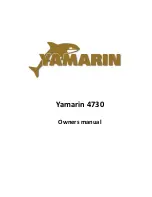
STORAGE/WINTERIZATION
PAGE 33
engine oil into the intake pipe or
manifold while engine is turning.
DO NOT USE
the starter to turn
engine or serious engine damage
may result.
6. Tape the openings of the intake
and exhaust manifolds with duct tape
to help prevent corrosion of the
upper cylinder during lay-up.
7. Scrape all rust or corrosion from
exposed metal parts and surfaces.
Scrub
all
metal
surfaces
with
detergent and rinse thoroughly. Paint
any bare metal.
8. Place a dust cover over engine.
Do not leave engine exposed to rain
and sea breeze.
9. Disconnect the battery cables;
remove the battery from the boat.
Clean the terminal ends and battery
with a solution of baking soda and
water and rinse thoroughly with
clean water. Apply a light coat of
grease on the terminal end of the
battery and cables. Store the battery
in a cool dry place. Use a trickle
charger to keep battery charged. Do
not charge battery near any open
flame or in a confined area.
CAUTION: Wear safety goggles
and rubber gloves to protect your
eyes and skin.
DEPARTURE FROM THE BOAT
The check list for leaving a boat
unattended
is
very
important
because items overlooked often will
not be remembered until you are far
from the boat and corrective actions
are impractical or impossible.
Primary choices for this list are items
relating to the safety and security of
the unattended craft: turning off fuel
valves, properly setting electrical
switches, pumping out bilge and
leaving the switch on automatic (or
arrange for periodic pumping out).
It
is recommended that the power
be turned off when leaving the
boat.
Other departure checklist
items are securing ports, windows,
hatches and doors.
ROUTINE MAINTENANCE
Routine
maintenance
checklists
should include items based on how
much the boat is used (usually in
terms of engine hours) and on
calendar dates (weekly, monthly or
seasonal checks). Typical of the
former are oil level checks and
changes, and oil and fuel filter
changes.
On a calendar basis the lists should
note such matters as electrolyte
levels in storage batteries, pressure
gauges
on
dry
chemical
fire
extinguishers, and all navigation
lights. Check the operation of
automatic bilge alarms or pump
switches by running water into the
boat. Periodically close and open
sea cocks several times to ensure
their free and easy operation in case
they are needed in an emergency.
Equipment and supplies carried on
board for emergencies should be
inspected
for
any
signs
of
deterioration.
Summary of Contents for 44DS
Page 28: ......
Page 39: ......
Page 40: ......
Page 41: ......
Page 43: ......
Page 45: ......
Page 46: ......
Page 47: ......
Page 50: ......
Page 52: ......
Page 53: ......
Page 54: ......
Page 55: ......
Page 56: ...43B 4268043B ENG NONE ...
Page 57: ...44A ...
Page 58: ...44B ...
Page 73: ...51 4268051 ENG NONE ...
Page 76: ......
Page 77: ......
Page 78: ......
Page 79: ......
Page 80: ......
Page 82: ......
Page 84: ......
Page 85: ......
Page 86: ......
Page 88: ......
Page 89: ...59B 4268059B ENG NONE ...
Page 90: ......
Page 91: ......
Page 92: ......
Page 93: ......
Page 95: ...60C 4268060C ENG NONE ...
Page 96: ......
Page 97: ......
Page 101: ......
Page 105: ......
Page 110: ......
Page 113: ......
Page 114: ......
Page 117: ......
Page 118: ......
Page 120: ......
Page 123: ......
Page 124: ......
Page 125: ......
Page 126: ......
Page 127: ......
Page 130: ......
Page 132: ......
Page 133: ......
Page 135: ......
Page 137: ......
Page 141: ......
Page 142: ......
Page 145: ......
Page 148: ......
Page 149: ......
Page 150: ......
Page 154: ......
Page 156: ......
















































